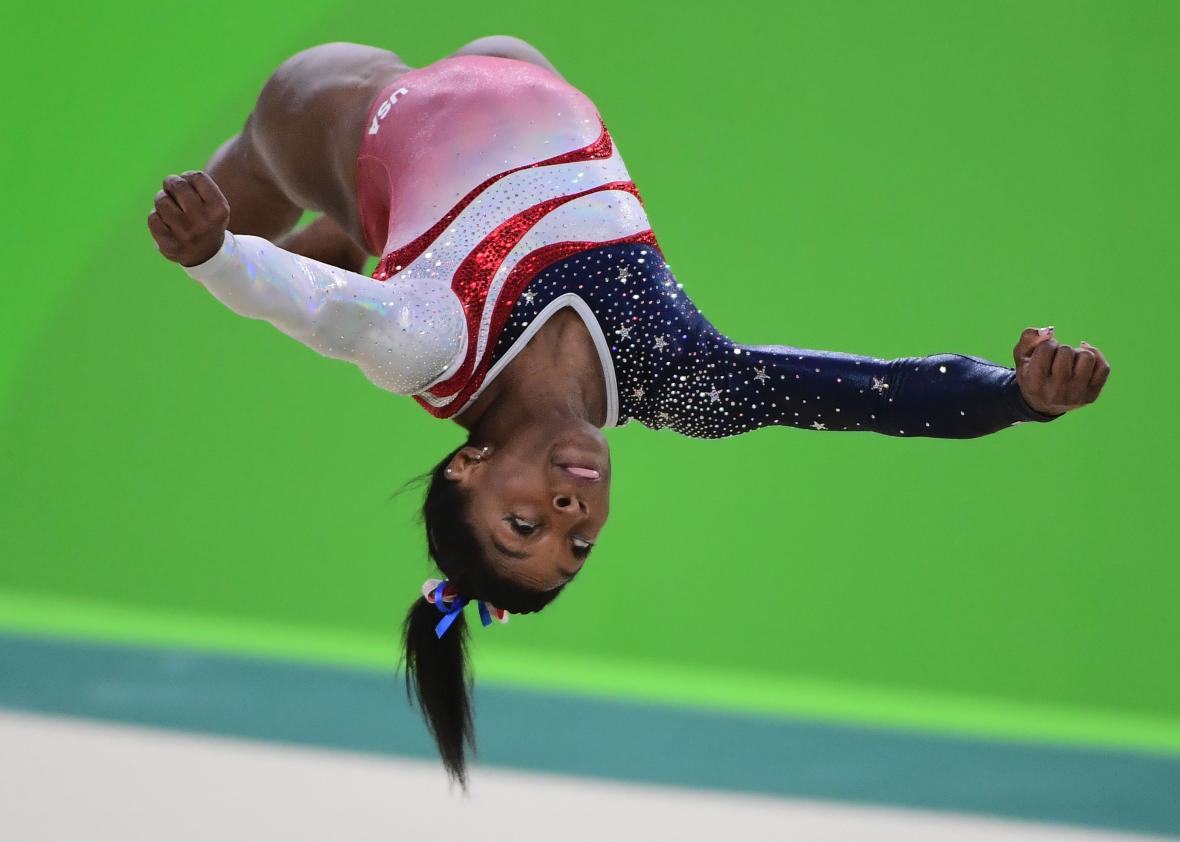On Aug. 7, Al Trautwig told viewers of NBC’s gymnastics coverage that they’d be advised to watch Simone Biles’ floor routine. “This is a bouncy floor,” Trautwig said, “and she’s going to make the most of it.” Biles did make the most of the springy surface, earning the top score of the night on floor in the qualification round (15.733), the team final (15.8), and the individual all-around (15.933).
How is Biles able to bounce so high off the floor? Mostly, because she’s a tremendous athlete. It also helps, though, that there are literal springs beneath the surface.
The sport’s governing body, the Fédération Internationale de Gymnastique, spells out numerous requirements for the floor exercise performance area. The floor “shall have a square format,” must “guarantee the gymnast stability and freedom of movement,” “must not produce disturbing sounds,” and “must not cause skin burns.” The surface at the Rio Games was provided by the French company Gymnova. The floor being used at the Olympics is called “Glasgow.” According to Gymnova’s promotional materials, the Glasgow exercise floor has “exceptional bounce and comfort.” The floor’s springs “are designed to provide the highest levels of responsiveness,” while their placement “ensures a consistent rebound across the entire floor area.”
The floor at the 2016 Olympics measures 14-by-14 meters and consists of three layers. The “base layer” consists of “sustainably sourced plywood … over 2,000 optimally positioned springs to provide a consistent response.” Each spring measures 11.3 centimeters in height. The “intermediate layer” is made of “high-density interlocking foam panels giving increased levels of comfort and shock absorption.” The “performance layer”—the carpet at the top—“consists of several strips joined together by hook and loop fastener bands.”
Once everything is assembled, the height of the floor is about 20 centimeters. The retail price of the Glasgow system varies widely, with listings ranging between about $31,000 and $46,000. That price includes the cost of installation but does not include shipping fees. If you’d prefer to install the floor yourself, Gymnova provides detailed assembly instructions. These YouTube videos, which reveal the guts of a modern mat, also show the steps involved in laying down a new gymnastics surface.
What does it feel like to bounce on a spring floor? Kelli Hill, the head coach of the U.S. women’s gymnastics team at the 2000 and 2004 Olympics, explains that it’s “pretty soft—it has give.” Crashing down on the floor doesn’t feel like smashing into asphalt, she says, but it certainly doesn’t feel good.
A spring floor launches tumbling gymnasts quickly—it pops you into the air much faster than, say, a trampoline bed, which has to sink down, then pop back up before sending you into the sky. How much, exactly, does a springy floor aid a gymnast’s performance? Hill says it’s impossible to do the sorts of high-flying tumbling passes that Biles has pioneered without advanced flooring technology. “Could they do a double back on a regular floor? They’ve done those … in history before spring floors,” Hill says. “But could they do the double twisting double backs without a spring floor? No, I don’t think so.”
In the early days of the modern Olympic Games, gymnasts didn’t bounce around on anything resembling today’s cushioned surfaces. A 2013 paper on the kinematics of tumbling published in the Science of Gymnastics Journal explains, “Tumbling and floor exercise apparatuses have evolved from dirt, sand, and grass to gymnasium wooden floors, horsehair-filled canvas-encased mats, wrestling mats, and various types and thicknesses of polyethylene foam sheets.” The floor exercise was added to the official Olympic program until 1932, at which point it was exclusively the province of male gymnasts; women were allowed to compete on the floor starting in 1952. According to the official report from the organizing committee for the 1936 Berlin Games, the floor exercise was performed on a firm plank “with a cork linoleum covering 0.28 inches thick and 26 feet square.” Things got a bit softer two decades later; the official report for the 1956 Melbourne Games describes the mat as “felt with canvas covering.” At the 1972 Munich Games, the floor was made of “25-millimeter-thick Oregon pinewood slats, a 14-meter square area of which was covered in heavy-duty carpeting.” Although the carpet burns must have been horrendous, the pinewood would have provided some amount of cushioning and shock absorption.
Hill, who was born in 1960, says she “started off on panel mats. Then it went to a wrestling mat, and then it went to a foam block floor.” According to that 2013 paper on tumbling kinematics, spring floors have been used in top-level competitions since at least 1979. “Initially, the height of metal coilsprings or foam blocks was approximately 5 centimeters,” the paper says. “Later, the height of the metal springs and foam blocks was increased to approximately 10 centimeters.” Bigger springs mean “increased elastic behavior with corresponding increases in tumbling height and skill difficulty” as well as “an increased fall distance and correspondingly greater impact forces.” More bounce, more height, more amazing twists and turns, and more danger—that’s what today’s springier-than-ever floors bring to the sport of gymnastics.
